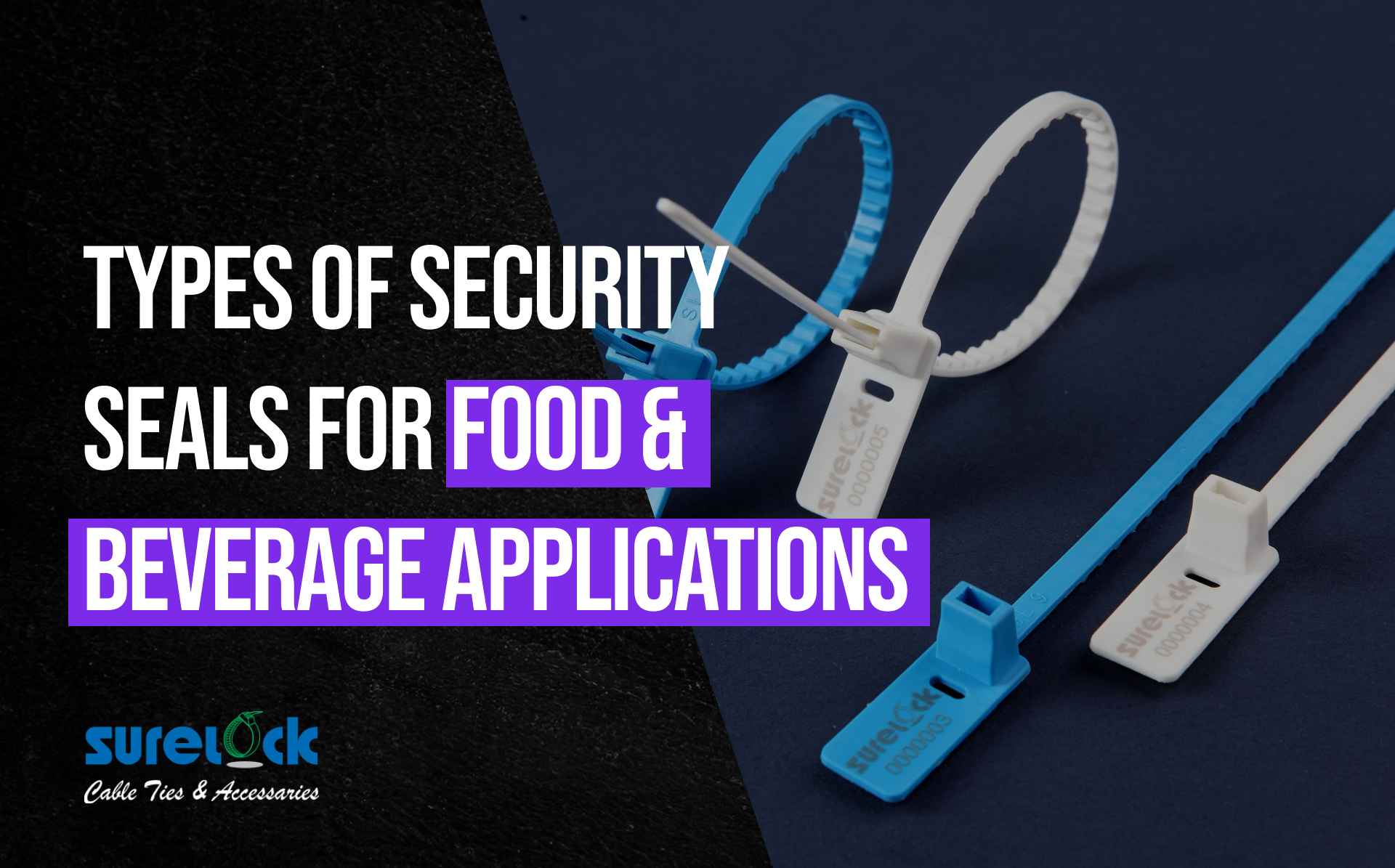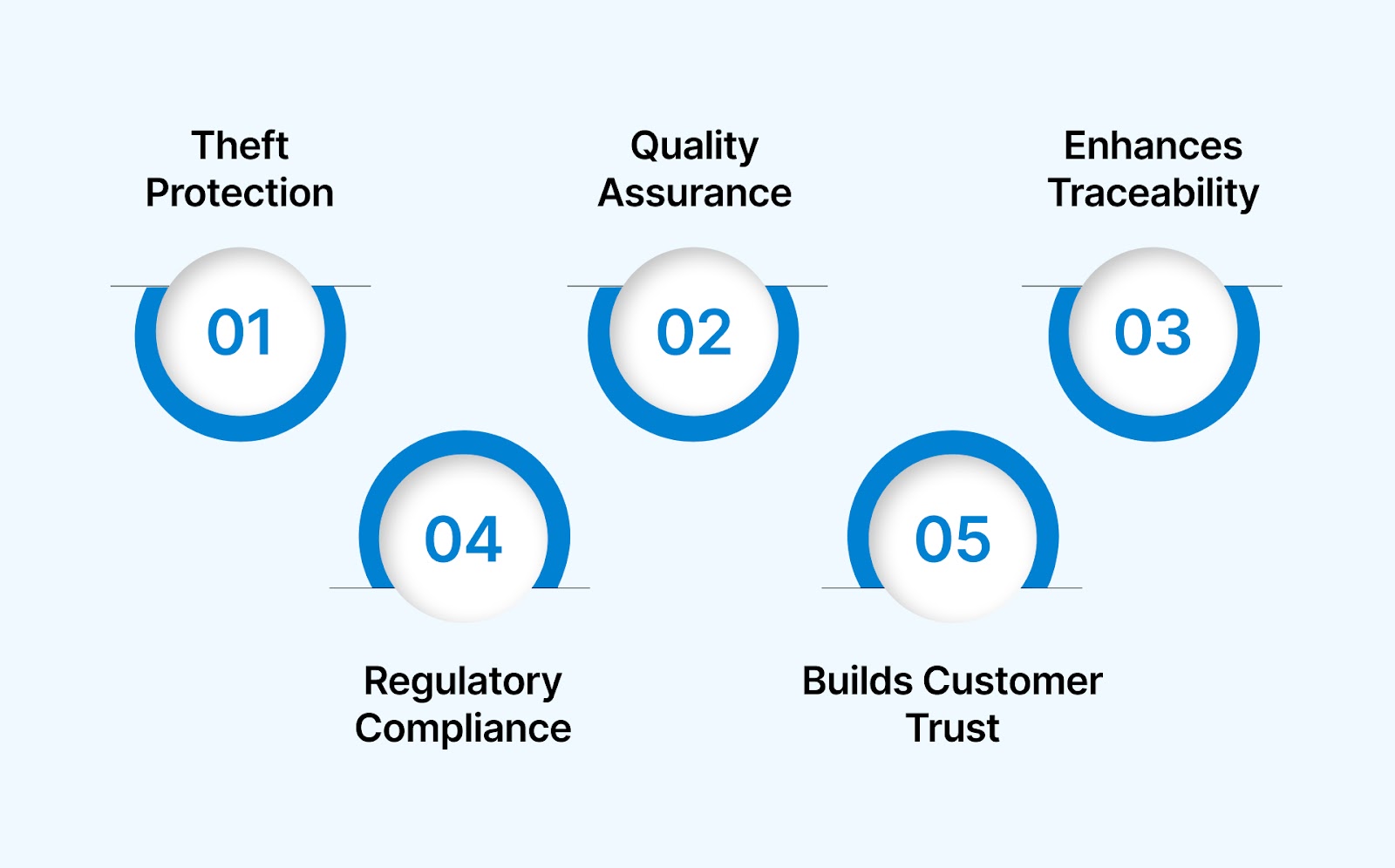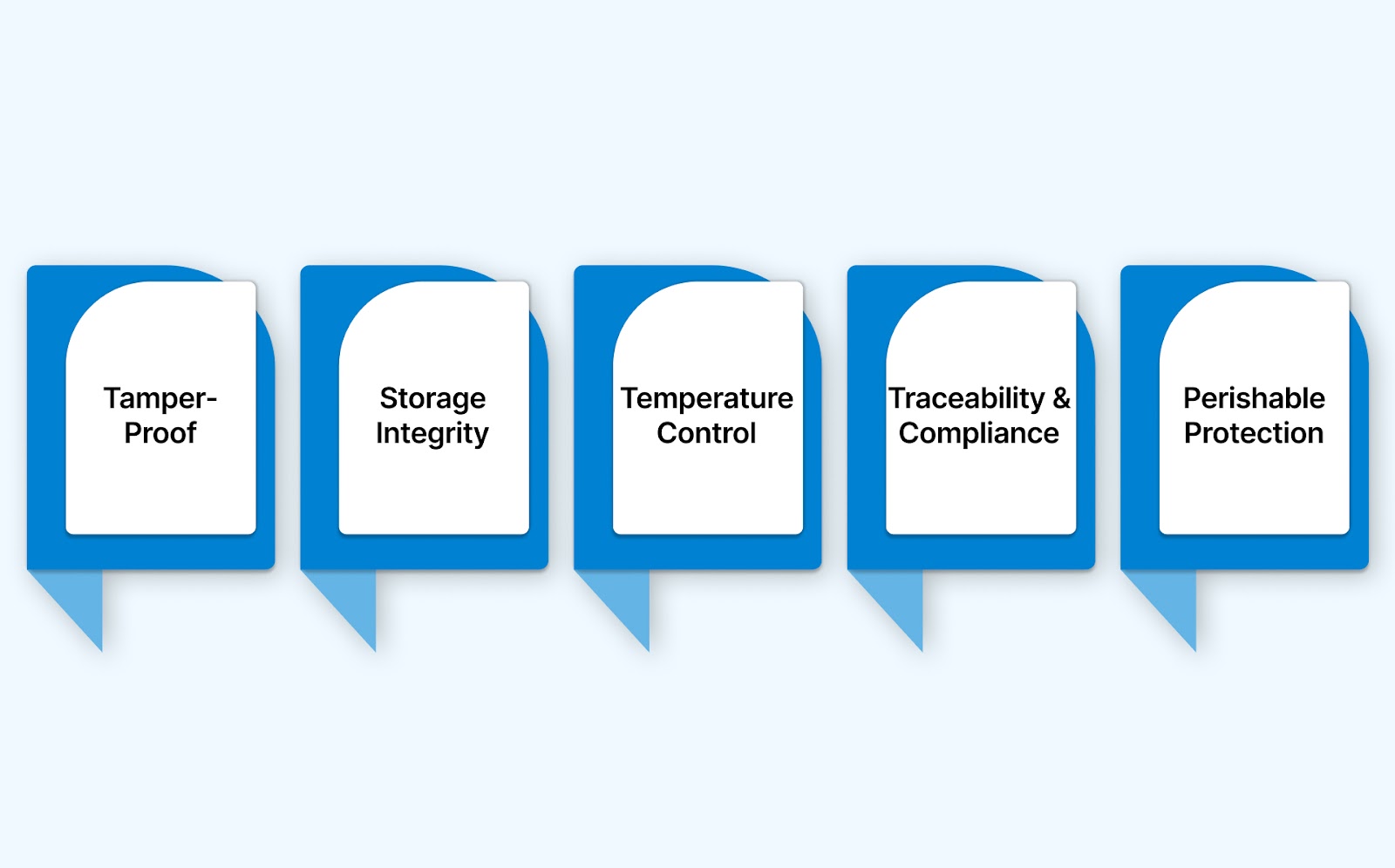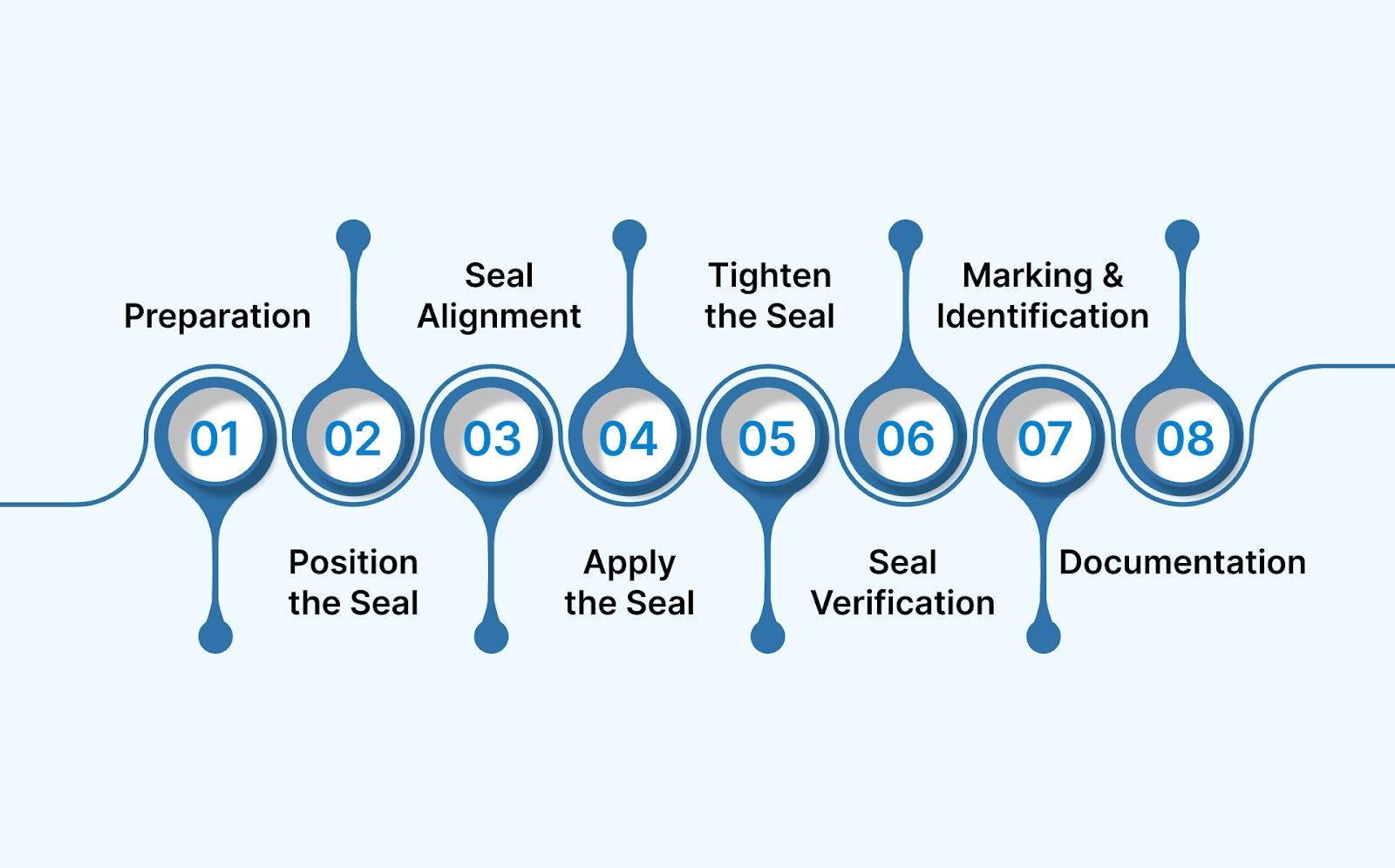Top Types of Security Seals for Food and Beverage Applications
August 1, 2025

How can you ensure your food and beverage products stay secure from tampering and contamination throughout the entire supply chain? In an industry where quality, safety, and trust are paramount, every single link in the chain, from production to distribution, needs to be safeguarded. That’s where security seals step in.
These simple tools play a critical role in ensuring that products arrive safely and without interference. From packaging and shipping to storage and handling, security seals guarantee that your food and beverage products remain tamper-free and maintain their integrity. But with so many different types of security seals available, how do you know which one is best suited for your needs?
In this blog, we’ll explore the various types of security seals commonly used in the food and beverage industry, discuss how to select the right one, and outline best practices for applying them. We’ll help you understand how to protect your goods and boost customer confidence in every step of the journey.
Types of Loads in the F&B Industry and Their Prerequisites for Safety

In the food and beverage industry, different types of products demand specific handling to maintain their integrity and ensure safety throughout the supply chain. Each category requires unique sealing methods to address its individual needs. Let’s explore the key types of loads and their safety prerequisites:
- Fresh and Frozen Foods: These products need continuous temperature regulation to maintain their quality and avoid contamination. Proper sealing of storage doors and packages ensures they remain intact during transit and storage, safeguarding against spoilage and bacterial growth.
- Beverages and Juices: Beverages must be sealed to protect them from external tampering. Security seals prevent unauthorized tampering, ensuring that the products remain fresh and free from contaminants. They help preserve the product's quality and also guarantee that no external factors compromise both taste and safety.
- Dairy Products: Dairy products are very sensitive to temperature changes. Even a slight deviation from the ideal temperature range can cause spoilage. Seals on their storage door or packages protect dairy products from air, moisture, or other contaminants that could impact their quality and shelf life.
- Meat and Meat Products: Meat products are prone to contamination and require strict hygiene during transit. Proper sealing on packages helps protect against bacterial exposure, ensuring that products remain fresh and safe for consumption as they travel from the manufacturer to the retailer.
Each product category has specific sealing needs that are crucial for maintaining high standards of safety and quality. Next, let’s dive into the security seals and how they ensure the safety of the goods in transit.
What Are Security Seals?
Security seals are crucial tools for securing containers, packages, or equipment, providing clear evidence of tampering or unauthorized access. Designed to protect goods during storage or transit, these seals help maintain the integrity and safety of various items across industries.
Made from various materials, security seals are often lightweight and tamper-evident. They provide a simple yet effective solution to deter theft, prevent contamination, and ensure that products remain secure throughout their journey.
In addition to safeguarding goods, security seals are crucial for meeting regulatory standards and ensuring compliance in sectors such as transportation, utilities, and food processing.
Now that we’ve defined security seals, let’s examine why they matter so much in the food and beverage industry.
Why are Security Seals Important for the Food & Beverage Industry?

In the food and beverage (F&B) industry, ensuring product safety and integrity is non-negotiable. Security seals provide a reliable way to maintain product quality and traceability throughout the supply chain. These seals play a crucial role in supporting compliance with industry regulations while ensuring the smooth flow of goods from manufacturer to retailer. Here are the benefits it provides:
- Prevents Theft and Tampering: Security seals provide a clear physical and visual deterrent, ensuring unauthorized access is immediately apparent.
- Maintains Product Quality: Seals ensure products remain intact and free from contamination during storage and transport.
- Enhances Traceability: Seals with unique identifiers allow businesses to track products and verify their safety from origin to destination.
- Regulatory Compliance: Many regulations in the food and beverage (F&B) industry require the use of security seals to meet health and safety standards.
- Builds Customer Trust: Knowing that products are securely sealed boosts consumer confidence, particularly in high-risk items like perishables.
With a clear understanding of their significance, let’s proceed to the types of security seals commonly used in the F&B industry.
Types of Security Seals Used in the Food & Beverage Industry

In the food and beverage industry, selecting the right security seal is crucial for protecting products during transportation and storage. Different types of security seals are designed to meet the specific needs of various food products, ensuring they remain tamper-proof and maintain quality. Let’s explore the different types of security seals commonly used in the F&B industry:
1. Security Seal Heavy Duty
This robust security seal is designed to provide reliable tamper-evident security for sealing doors, bags, and drums in the food and beverage industry. Let’s explore its key specifications:
- Applications:
- Sealing doors
- Sealing bags
- Sealing drums
- Material:
- Nylon or
- Polypropylene (PP)
- Operating Temperature:
- −40°C to +85°C
- Features:
- Self-locking, single-point locking design ensures tamper-evident security.
- Adjustable length to fit various diameters.
- Integrated identification tag for laser marking, logos, and numbering to assist with tracking.
- Environmentally friendly and fully recyclable, with no metal parts.
2. Double Lock Seal Heavy Duty
Offering tamper-evident security, it is mainly used for sealing doors, bags, and drums in the food and beverage industry. Here are its key specifications:
- Applications:
- Sealing doors
- Sealing bags
- Sealing drums
- Material:
- Nylon
- Polypropylene (PP)
- Operating Temperature:
- −40°C to +85°C
- Features:
- Single-point locking mechanism for clear evidence of tampering.
- Adjustable length to secure a wide range of item sizes.
- Marking tag for easy identification and tracking.
- Metal-free, fully recyclable for environmental sustainability.
3. Adjustable Ball Pull Up Seal
This innovative seal features a self-locking design that ensures firm locking of the cone with a ball-shaped adjustable length, offering maximum protection in food and beverage operations. Below, we have mentioned its key specifications:
- Applications:
- Sealing door locks
- Sealing drums
- Sealing bags
- Material:
- Nylon
- HDPE (High-Density Polyethylene)
- Operating Temperature:
- −40°C to +85°C
- Features:
- Self-locking mechanism with a locking of cone for secure closure.
- Adjustable ball-shaped length design accommodates various diameters.
- The acetal insert locking mechanism provides enhanced tamper-proof security.
- Free from metal parts, ensuring full recyclability.
4. Mini Ball Pull Up Seal
A compact solution, this seal is perfect for low-breaking-strength applications. Despite that, it still delivers reliable tamper-evident security. Here are the key specifications it comes with:
- Applications:
- Sealing small boxes
- Sealing cabinets
- Material:
- Nylon
- Polypropylene (PP)
- Operating Temperature:
- −40°C to +85°C
- Features:
- Thin strap design fits most locking rings and equipment locks.
- Cone-ball shaped design for adjustable length and versatile use.
- The acetal insert locking mechanism offers tamper-proof security.
- Available with plain or rip-off tags for easy removal.
These security seals are critical for the food and beverage industry, providing essential protection against tampering and contamination. However, that’s not all; there are other types of security seals to consider.
Other Types of Security Seals You Can Consider
Apart from the ones mentioned above, there are a few other types of security seals Surelock offers for you to consider for various applications. Below are the details of different security seal types and their key characteristics, which help ensure the safety of products during transit and storage:
Surelock provides an extensive range of security seals, from adjustable ball pull-ups to heavy-duty options, ensuring maximum protection and compliance for your food and beverage products.
Having explored the different types of security seals, let’s look at how they are applied to ensure safety in the food and beverage industry.
Applications of Security Seals in the F&B Industry

In the food and beverage industry, security seals are used in various contexts, each designed to meet specific requirements such as preventing contamination, maintaining proper storage conditions, and ensuring traceability. Let’s discuss the key applications of security seals and how they support the industry's rigorous standards.
- Ensuring Tamper-Proof Transport: Security seals help prevent unauthorized access to food and beverage products during transit, safeguarding the products against tampering and ensuring they arrive intact and unaltered.
- Maintaining Product Integrity in Storage: Seals on containers and packaging help keep products secure and free from contamination while stored in warehouses or distribution centers, reducing the risk of mishandling or unauthorized access.
- Verifying Temperature Control: For temperature-sensitive items such as dairy, meats, and frozen foods, security seals on refrigerated containers ensure that the proper temperature has been maintained throughout transit and storage.
- Supporting Traceability and Compliance: Seals with unique identifiers allow for detailed tracking of food products from origin to destination, ensuring traceability in the event of recalls and supporting regulatory compliance.
- Protecting Perishables and Sensitive Goods: Security seals are essential for securing perishable goods, ensuring that products such as fresh produce or meat remain sealed and free from contamination throughout the supply chain.
These applications of security seals play a crucial role in keeping food and beverage products safe, secure, and compliant, thereby ensuring both consumer protection and business integrity in the food and beverage industry.
Now that we know how security seals are applied, it’s time to understand how to choose the right seal for your products.
Also read: Cable Identification Tags for Wires and Cables
Choosing the Right Seal: Protecting Food & Beverage Products with Confidence
Selecting the right security seal is crucial for ensuring the safety, integrity, and traceability of your products. The right seal can protect your goods from tampering, ensure compliance, and maintain consumer confidence. Here are the key factors to consider when choosing the appropriate security seal for your F&B products:
- Material Compatibility: Choose seals made from durable materials that are resistant to the conditions your products will face. For the food industry, nylon and polypropylene are commonly used for their ability to withstand varying environmental conditions.
- Temperature Resistance: Ensure the seal can perform under the required temperature conditions. For perishable goods, select seals that can withstand both cold and hot environments to maintain product integrity during transportation and storage.
- Tamper-Evident Features: Look for seals with clear tamper-evident features such as breakable locks, irreversible designs, or security markings. This ensures that any unauthorized access to the product is immediately visible.
- Ease of Use and Application: Choose seals that are easy to apply and remove. Some seals offer adjustable lengths or tools that make installation efficient and reduce handling time, which is critical in fast-paced production and shipping environments.
- Traceability and Identification: Opt for seals that allow for easy identification and traceability. Seals with laser-marked numbers or barcodes enable better tracking throughout the supply chain, improving security and accountability.
- Environmental Impact: Consider the environmental impact of your security seals. Many food and beverage companies prioritize sustainability, so choosing recyclable or eco-friendly materials can help reduce their environmental footprint.
- Cost-Effectiveness: While security is paramount, cost is also a consideration. Choose seals that offer a balance between quality, security, and price. The right seal should provide value while ensuring the safety and compliance of your products.
Moving on, we’ll cover how to effectively use and install security seals in the food and beverage (F&B) industry.
How to Use and Install Security Seals in the Food & Beverages Industry

Proper installation of security seals is essential for ensuring the safety and integrity of food and beverage products. The process needs to be efficient, secure, and compliant with safety standards to protect your products. Here’s a step-by-step guide to using and installing security seals effectively:
- Preparation: Before applying the seal, ensure the container or packaging is clean and secure. Double-check that the item you’re sealing is free from contaminants and the packaging is intact.
- Positioning the Seal: Place the security seal at the designated point of closure (e.g., on doors, containers, or packaging) to prevent unauthorized access. The seal should be positioned so that it is visible and easily identifiable.
- Align the Seal Properly: Insert the locking mechanism into the seal or clip. Ensure that the adjustable component is securely positioned to hold the seal in place.
- Apply the Seal: For adjustable seals, pull them snugly without over-tightening. For bolt seals, ensure the bolt is securely inserted into the seal head and tightened appropriately.
- Tighten the Seal: If necessary, use a tensioning tool to achieve the appropriate tightness for the seal, especially for heavy-duty applications. This ensures it remains tamper-evident and secure.
- Verify the Seal Integrity: Once applied, double-check that the seal is secure, with no loose ends or possible entry points. Confirm the locking mechanism is fully engaged.
- Marking and Identification: If applicable, mark the seal with necessary information, such as a date, serial number, or other identifying details. This will help in tracking and monitoring.
- Documentation: Maintain records of the seal application for traceability. This includes tracking seal numbers and associated shipment or packaging details for future reference.
By following these installation steps, you can be confident that your food and beverage products are properly secured. But installation is just one part of the process; let’s review best practices to maximize the effectiveness of security seals.
Also read: How to Use and Tighten Stainless Steel Cable Ties
Best Practices for Using Security Seals in the Food & Beverages Industry

Using security seals correctly is key to safeguarding food and beverage products throughout their journey from production to delivery. To maximize their effectiveness, here are some best practices to follow:
- Regular Inspections: Periodically check seals for signs of wear or tampering. Ensure the integrity of the seal is maintained throughout the storage, transportation, and handling process.
- Proper Seal Selection: Choose the right type of seal based on the product's needs. Heavy-duty seals may be necessary for high-value items, while lighter seals can be suitable for less-sensitive products.
- Clear Visibility: Ensure that security seals are easily visible and properly applied to prevent tampering. They should be positioned in an obvious way to all parties handling the product.
- Training Staff: Ensure that all personnel involved in sealing, handling, and monitoring products receive proper training in the use of security seals. This helps prevent improper application or oversight.
- Avoid Over-Tightening: Ensure seals are applied tightly but not excessively, which could damage the product or the seal. The seal should hold securely without causing any undue pressure.
- Seal All Vulnerable Points: Seal doors, hatches, containers, and packaging that are at risk of tampering. This ensures that all potential entry points are protected.
- Disposal and Replacement: Properly dispose of any broken or damaged seals and replace them promptly. Keeping seals in good condition is essential for maintaining their protective function.
Adhering to these best practices can ensure that your food and beverage products remain safe and secure, ultimately building consumer confidence and protecting your brand’s reputation.
Conclusion
In the food and beverage industry, security seals are crucial in maintaining product integrity, preventing tampering, and ensuring compliance with safety standards. From safeguarding products during transportation to ensuring proper storage conditions, these seals play a key role in protecting consumer trust and reducing risks across the supply chain. When selecting the right seals for your food and beverage applications, choosing ones that align with your specific needs is vital.
For high-quality, reliable options, Surelock offers a comprehensive range designed for a variety of food and beverage needs. Their seals, such as the heavy-duty and adjustable ball pull-up seals, provide both security and ease of use. Ensure your products remain secure, compliant, and tamper-proof.



